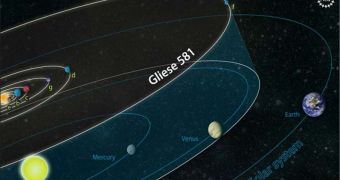Some of you may remember the name of the exoplanet Gliese 581g as the first ever extrasolar body to be found orbiting its star inside the habitable zone, which allows for the existence of liquid water.
This made astronomers refer to it as the “second Earth,” and caused quite a stir in the international scientific community. The implications of these findings are staggering.
First of all, being located inside the habitable zone means that temperatures revolve between 0 and 100 degrees Celsius, with little variations on both ends. Liquid water is therefore a possibility.
The discovery of this remarkable planet, which is only moderately larger than Earth, was announced in a journal paper on September 29.
Shortly after University of Western Sydney astronomer Ragbir Bhathal claimed that he saw a pulse of light coming from the same galactic direction as the location of the exoplanet some two years ago.
Bhathal, who is a member of the SETI Institute chapter of Australia, has been met with cold skepticism when he made the claim, Space reports.
“Whenever there's a clear night, I go up to the observatory and do a run on some of the celestial objects,” Bhathal said for the Daily Mail when he made the initial announcement.
“Looking at one of these objects, we found this signal. We found this very sharp signal, sort of a laser lookalike thing which is the sort of thing we're looking for – a very sharp spike. And that is what we found,” he explained.
But even scientists that have been involved with SETI before, and played an important role in the Institute's history, said that they were skeptical about the announcement.
“I know the scientist, and when he first announced it, I asked him for the details, and he wouldn't send them to me. I'm very suspicious,” says SETI pioneer Frank Drake, who is an astronomer himself.
Some of you may know this scientist by his formula, called the Drake Equation, which seeks to determine the number of alien worlds that may be sufficiently developed to enable communications.
One of the suspicious things about the new announcement is that Bhathal claims to have seen the light signals in December 2008, nearly two years before the Earth-like exoplanet was found.
At that time, astronomers say, there were no clues that the star Gliese 581 had any planets around it whatsoever.
“I'm not aware of the location that was claimed for the source of that light, and [Bhathal] refused to tell me where it came from,” Drake goes on to say.
“I think it's very unlikely that it came from the direction of Gliese 581,” he concludes.

 14 DAY TRIAL //
14 DAY TRIAL //